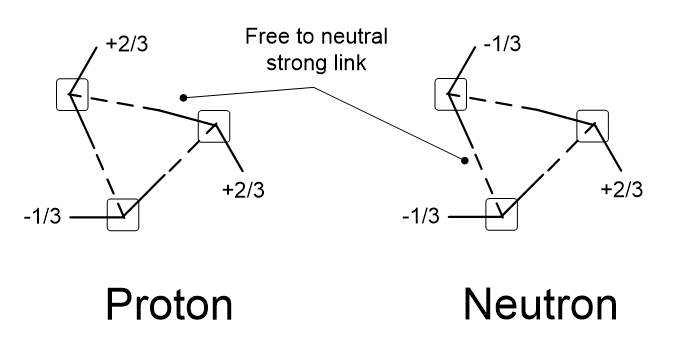
The atomic nucleus, once thought indivisible, is now known to consist of protons and neutrons that in turn are made of quarks. A proton is two up quarks and a down quark, and a neutron is two down quarks and an up, so the odd quark charges add nicely to make one positive and the other neutral (Table 4.4). But how do unstable quarks combine to give stable protons and neutrons?
 Table 4.5 shows how one quark can share photons with another to stabilize it. In 4.5A, some free photons of Quark1 fill channels in the neutral axis of Quark2 to connect them, which produces no remainder in either quark. In 4.5B, this frees some photons in the second quark’s neutral axis to return the favor, to further link the quarks. Being now connected, photons in Quark2 can occupy the free channels of Quark1 until its free axis is full. Again, this sharing doesn’t alter the charge of either quark, but it makes both axes complete and so stable (Table 4.5C). Photon sharing then stabilizes Quark1 by filling the channels of its free axis.
Table 4.5 shows how one quark can share photons with another to stabilize it. In 4.5A, some free photons of Quark1 fill channels in the neutral axis of Quark2 to connect them, which produces no remainder in either quark. In 4.5B, this frees some photons in the second quark’s neutral axis to return the favor, to further link the quarks. Being now connected, photons in Quark2 can occupy the free channels of Quark1 until its free axis is full. Again, this sharing doesn’t alter the charge of either quark, but it makes both axes complete and so stable (Table 4.5C). Photon sharing then stabilizes Quark1 by filling the channels of its free axis.

This completes the first quark, then the second quark can fill its free axis by linking to a third quark, that can fill its free axis by linking to the neutral axis of the first. In Figure 4.13, quarks in a triangle structure share photons to all become stable, giving a proton or neutron depending on the quark mix. Now what holds quarks together isn’t the push of gluons from space but the pull of photon sharing.
What then are the red, blue, and green charges of the standard model? Each quark must orientate differently to connect in a triangle, so they are just its three orientations. In a world of particles, an agent has to cause every change but in the quantum world, new events occur naturally every cycle. A photon that can’t occupy a channel because another got there first, just tries again elsewhere.
For example, imagine pouring wine on a stack of empty glasses. When the water fills one glass, it just flows on to the next, until every glass is full. Nothing directs this activity or decides which water fills which glass, yet they always fill. Now suppose that when every glass is full, the weight restarts the system, so all the glasses empty and a new pouring cycle begins. Likewise, photons fill every channel they can until a network overload restarts them.
The quantum world tries every option until a stable entity forms, like protons, neutrons, electrons, and neutrinos. Conversely, unstable results that exist for a moment then decay are like species that don’t survive, irrelevant to the future. That matter is inert and only changes when acted upon is like the tabula rasa theory that children are blank slates upon which we write. Psychologists no longer believe this (Pinker, 2002), but physics still thinks the universe is a blank slate. The quantum flux, like a child, is constantly active of its own accord, so it doesn’t need particles to push it around.
To recap, quarks share photons in a triangle structure to form protons and neutrons that are stable, and this occurs naturally, not based on virtual gluons spawned by a strong field. How then does this model explain the weak force?